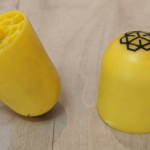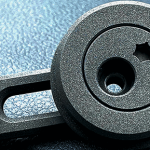- Home
- 3D Printing
- Should you buy your own 3D printer?
Should you buy your own 3D printer?
As a specialist prototyping company, we are well aware of the benefits of 3D printing. Moreover, if you are reading this you probably appreciate how 3D printing saves time and money when you need three-dimensional representations of your designs.
Over the last 20 years, 3D printing technology has matured, more processes have been commercialised, and costs have fallen, for some of the technologies. Not surprisingly, therefore, design consultancies have started to invest in their own 3D printers instead of – or as well as – using rapid prototyping bureaux. But is this always the best thing to do?
Why buy a 3D printer?
When pitching to a new client, a design consultancy will find it helpful to say they have their own 3D printer. Likewise, a client may feel more comfortable engaging a consultancy that has in-house 3D printing.
Design consultancies can certainly benefit from having a 3D printer – for example, they can quickly produce multiple variants of a design for presenting to a client. And sometimes a physical representation of a complex 3D component will help engineers, designers and the client gain a better understanding of a particular issue. It is said that a picture is worth a thousand words but a 3D model is, in many respects, better than a 2D rendering, 3D CAD model or a set of engineering drawings.
Which 3D printer should you buy?
If the idea of investing in a 3D printer sounds attractive, the next question is which technology you should opt for. This is where everything suddenly becomes more complicated.
3D printing is not a single technology. Leaving aside metal 3D printing, which is another step up in complexity and cost, here are five different 3D printing technologies:
- SLA (stereolithography) – produces highly detailed parts with a good surface finish. Parts are not porous and they have good strength, stiffness, isotropy and dimensional stability. The technology works by using light to cure liquid photopolymer resins, so material choices are limited. SLA is a high-quality process and can be used for making prototype parts or master patterns for vacuum casting polyurethane parts.
- SLS (selective laser sintering) – parts are characterised by high accuracy, strength, stiffness and long-term dimensional stability. Resistance to abrasion means parts are suitable for moving mechanisms. Parts are built relatively rapidly from powder but the choice of materials is limited (eg PA2200 Nylon).
- FDM (fused deposition modelling) – this process uses filaments rather than powder, which it more user-friendly. The cost-per-part is comparatively low. There is a reasonable choice of material but quality and surface finish are heavily dependent on the material (hence we only use ABS-M30 production-grade material). Although the printing technology is basically the same as that used in low-cost hobbyist machines, our more expensive, industrial, FDM printers produce high-accuracy parts with a good surface finish.
- PolyJet – this is the name Stratasys uses for its multi-material 3D printing technology. This gives far more choice over the material properties for the finished part. For example, we often use PolyJet to produce prototypes of parts that will ultimately be overmoulded with thermoplastic elastomers.
- DLP (digital light projection) – this process is similar to SLA but much faster and the machines are more expensive. It uses light to cure a liquid photopolymer resin, parts are isotropic and non-porous, and accuracy is sufficient for producing master patterns for vacuum casting. As with SLA, the choice of materials is limited.
In addition to these five technologies, which are the ones we have in-house, there are others available from a variety of manufacturers. Prices vary enormously from around £1000 for a hobbyist FDM machine to hundreds of thousands of pounds for a high-end industrial 3D printer capable of operating reliably all day and all night. The purchase price also depends on the size of the build envelope.
Of course, if you want high-quality parts, you need a high-quality 3D printer. We have some 20-year-old machines that still produce superior parts because they were constructed using top-quality components and have been consistently maintained.
Additional costs
If you are thinking of investing in 3D printing, remember to look at the associated costs, not just the purchase price of the 3D printer. Some machines are described as office-friendly but others need dedicated facilities. In addition, equipment could be needed for cleaning, washing, curing, sealing, sanding, painting and other post-processing operations. These will depend on the chosen 3D printing technology and the level of finish desired.
You must also be aware of and comply with the COSHH (Control of Substances Hazardous to Health) Regulations. Again, it depends on the 3D printing technology but, for example, SLA and DLP liquid resins need handling with care, and SLS powder presents its own hazards. Before investing in a 3D printer, you need to know how the materials will be stored, moved and disposed of.
To get the most out of a 3D printer, particularly if you have bought a high-end machine, the operative needs a very good understanding of it. This extends beyond optimising the settings for each build, to include cleaning, making adjustments and routine maintenance.
Buy or outsource?
Whether to buy a 3D printer or outsource your 3D printing depends on many factors. Earlier we discussed the ‘soft’ issues relating to client expectations but there is also a business case to answer. Does it make sense, financially, to invest in 3D printing? And if you do invest, are you sure that the technology you chose will be appropriate for the majority of your requirements? After all, it is unlikely that more than one type of 3D printer will be purchased.
Can you make a 3D printer work hard enough that it will pay for itself? Our 3D printers often run at full capacity, 24 hours per day, but a consultancy will need to be sure there is enough in-house demand for prototype parts that the machine – and maybe its operative – will not be idle for too long.
Sometimes the business case is made and a consultancy benefits enormously from its chosen 3D printing technology, but that is not always the case. It is vital to consider all the factors fully before committing to in-house 3D printing.
Talk to us
Whatever your 3D printing requirements, talk to us on 01763 249760.





